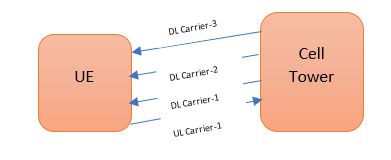What is Carrier Aggregation?
Carrier aggregation is the software feature in Radio Access Network and user equipment that enable operators to combine radio cell capabilities at distinct frequency allocation to improve end user experience.
Carrier aggregation is not a new technology for 5G. We have seen carrier aggregation in 4G as well.
Carrier aggregation in 4G gives around 1 Gbps throughput and it will provide around 4 Gbps in 5G.
We can achieve improvement of coverage and capacity both with the help of 5G Carrier Aggregation.
Carrier aggregation in 5G will play key role to fulfil the promise of 5G SA.

UE first connect with one carrier for both uplink and downlink. This the primary cell (pCell).
After that, second DL carrier can be added. These are secondary cells (SCells). Secondary carriers are only DL, UL is not used on these carriers. Carrier-1 is PCell and carrier-2 and carrier 3 are SCell in above diagram.
Carrier, Capacity and Coverage
Each frequency layer is called carrier. Each carrier is having different characteristics.
As we know, frequency is inversely proportional to wavelength. Higher frequency is having shorter wavelength and less capability to penetrate obstacle like concreate wall. But higher frequency is having more capacity.
Similarly, smaller frequency is having higher wavelength and have more penetration power. This is good for wide area coverage and indoor coverage. But lower frequency is having low capacity.
Lower frequency bands are normally used in Frequency Division Duplex (FDD) mode and FDD has higher uplink signal strength compared to TDD (Time Division Duplex). TDD is widely used for mid band frequency sub 6 GHz. Mid band frequency provides good coverage and capacity as well.
Most of the operators are getting license for 5G from each low, mid, and high frequency band. Carrier aggregation is the key technology to optimally use these carriers all together.
Carrier Aggregation in 5G
Operators are going with 5G NSA deployment where existing 4G radio network and core network will be used. 5G NSA architecture allows operators to increase bandwidth by combining 4G and 5G carriers using 4G and 5G dual connectivity. Here operators can do the carrier aggregation with existing 4G LTE along with up to two 5G carrier.
But true 5G is based on 5G NSA architecture where separate 5G network is available including radio access network and core network. There is no dependency on existing 4G LTE network in case 5G NSA deployment.
Key benefits of 5G carrier aggregation
Higher data speeds and throughput
5G carrier aggregation is going to increase network capacity which will fulfil the requirements of data centric application like virtual reality and augmented reality for consumer and industrial use cases.
Improved cell coverage
Operators are now trying to use all available spectrum assets in TDD and FDD bands. Carrier aggregation is the key option for extending coverage without deploying new cell site. This will be huge cost saving for operators. It will also improve consistent user experience.
Increase energy efficiency
Carrier aggregation will provide extended coverage and it will reduce new cell site deployment. Less cell site means less power consumption. User equipment battery power will also save due to better coverage. So, frequent charging is not required due to long battery life.
Good ROI
Frequency spectrums are very costly assets for operators. Operators can save huge amount by efficiently using of the available spectrum.
FAQ
What is the use of carrier aggregation?
Carrier aggregation is used to combine all available frequency band to increase data speed and coverage.
Can LTE and 5G be aggregated?
Yes, LTE and 5G can be aggregated together for 5G NSA deployment.
Is 4G+ and carrier aggregation same?
Carrier aggregation technology is not new for 5G. It is even started from 3G and 4G and it can also be used in 5G.
How many carriers does 5G have?
Normally, we are seeing multiple carriers from low band, mid band and high band for each operator.